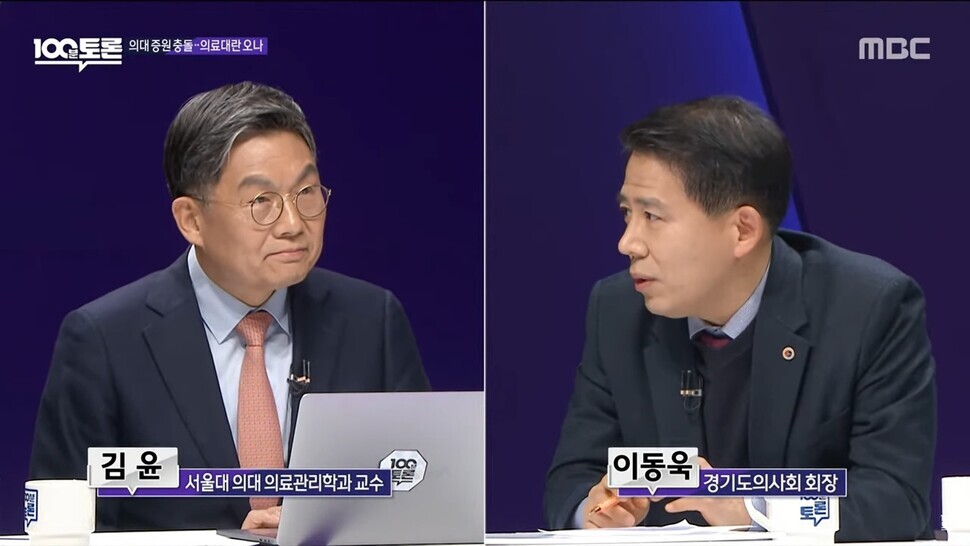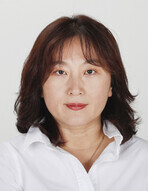hankyoreh
Links to other country sites 다른 나라 사이트 링크
[Column] How Dr. Kim Yoon became public enemy No. 1 for Korean doctors


By Kim Young-hee, executive editor
Last week, the New York Times reported that the Albert Einstein College of Medicine in the Bronx, New York, received a donation of US$1 billion. The Bronx has a high rate of premature deaths and is considered New York’s unhealthiest and most impoverished county. According to the story, Ruth Gottesman, a 93-year-old widow of a Wall Street financier, gave the donation with instructions that the funds be used to provide free tuition to all students going forward. Gottesman was also a longtime professor at Albert Einstein.
At first, I was jealous of the financial power of the American noblesse oblige — that is, until I discovered that half the students at Albert Einstein are saddled with around US$200,000 in student loan debt.
What’s the financial situation of the average Korean medical school student? According to data from the Korea Student Aid Foundation — secured by former People Power Party lawmaker Kim Byung-wook three years ago — 19.4% of newly admitted medical school students in 2020 fall into the income brackets 1 through 8 (the lowest earning). Over 80% of them fell into categories 9 and 10 (highest earning). Conversely, some statistics from the US suggest that around 50% of American medical school students fall in the top 20% income bracket.
Yet wealth doesn’t determine an individual’s commitment to the Hippocratic oath. Just because our medical schools are filled with pupils nourished under a lavish private education system doesn’t mean we have more doctors who will put money before patients.
Yet after seeing doctors’ radical opposition to government policies designed to increase the number of medical students nationwide, it’s hard not to conclude that their actions are linked to their wallets. If they hadn’t banded together against mandatory treatment packages that would make certain treatments complimentary, perhaps I would have understood their position.
Hospitals rely heavily on the cheap, long-hour labor of residents and interns, and our government and society view such a situation as natural or normal. In 2021, South Korea had 2.6 doctors per 1,000 people, a figure which includes doctors practicing traditional medicine. This is the second lowest among OECD countries, after Mexico. Practitioners avoid going into the fields where they’re needed the most, opting to make a living as dermatologists and plastic surgeons instead.
Does anybody else see this larger picture as the ultimate problem? If the protesting and striking doctors had seen it, perhaps they would have demanded that the government propose more concrete plans that include the pesky fiscal details — instead of just shouting “No” at the top of their lungs.
The argument that the government is fixated on arbitrary numbers and forcing through half-baked plans is valid. Suddenly injecting more medical school students into the system would likely cause some bottleneck problems and temporary overcrowding, but that’s clearly not the only thing the protesting doctors are concerned about. It’s obvious that they’re clinging to a level of privilege — and the media and the public have turned against them for it.
Kim Yoon, a professor of health policy and management at Seoul National University College of Medicine, is really the only prominent figure in the medical community who has pointed this out. As a panelist on MBC’s “100 Minute Debate” current affairs program, Kim explained that due to a shortage of doctors, the average annual salary of a doctor at a major hospital has increased from a little over 200 million won (US$150,000) to around 300-400 million won (US$225,000-300,000).
His appearance on the program earned him the ire of his colleagues. The Korean Medical Association (KMA) put out a newspaper ad lambasting Kim. “Professor Kim!” the ad read, “Do you even know why we’re protesting?” The ad effectively labeled Kim as public enemy No. 1. Last October, Kim wrote a column published by News 1 Korea. In it, he discussed the various medical policy frameworks adopted by other advanced countries.
He also targeted the behavior of Korean doctors by saying, “The claim that only the top 1% of students can become competent doctors is false news designed to protect their wallets.” The KMA responded with its own disciplinary measures against Kim, and the Korea Medical Practitioners Association has boycotted all organizations to which Kim belongs.
Kim has actually called for changes in ER management and in the systems through which health care is delivered for a long time now. Even now, he still views the distribution of doctors and the delivery of health care as more pressing issues than the simple number of doctors available.
Perhaps the current administration has labeled him as a friend of the previous administration, because the Yoon administration hasn’t consulted him whatsoever in any of its policy measures. So why would Kim go through the trouble of standing on the Yoon administration’s side and becoming a public enemy of his colleagues?
After completing his internship, Kim claimed, “I wanted to contribute to a society where the underprivileged get better.” He therefore opted to go into health policy and management. His professional curiosity led him to see the fundamental problems in the way the country’s ERs operate. As far back as 1995 to 1997, he was calling on the government to act. “If the government does not get moving right now, future policy proposals will be of no use,” he pleaded.
In 1999, he co-authored research about “preventable deaths from trauma” and submitted it to the Health Ministry. His research discovered that over 50% of trauma patients died because they weren’t treated during the precious golden time window that would have saved their lives.
“The government, however, classified such data as confidential,” he lamented.
The following year, the KBS network acquired the information, supplementing it with additional investigation and reporting it for two consecutive evenings as the lead story on the nine o’clock news. Everything was turned upside down.
The National Assembly took action, and the emergency medical service fund was dramatically increased.
“But the doctors’ first response to the report was to ask who had leaked it, not to see this as an opportunity to fix things,” Kim said. “That’s when my perceptions of physician groups started shifting.”
He would run into strong resistance from doctors time and time again in his subsequent efforts to improve the family doctor system, health care delivery system, and fee and payment systems.
Effectively giving up on trying to win their support, he began focusing instead of raising the public’s awareness of the need for health care reform, contributing nearly 50 columns to different outlets last year.
“I was genuinely worried that the health care system was going to collapse within a few years,” he explained.
The aging population trend predicted for 10 years into the future was not the only issue. It was also apparent that by around 2026, when new hospitals with 6,000+ total beds that are under construction in the Seoul area (including Severance, Asan, and Seoul National University) begin opening, the few doctors remaining at provincial hospitals would get sucked up by their gravitational force.
“Increasing the medical college admission cap was something that any administration that came to office would have to start pursuing again,” he said. “If they can’t manage it this time, the next [increase] will end up being 3,000 or 4,000 students.”
“Those aren’t political numbers. It grows together with the seriousness and suffering that people perceive,” he added.
Recently, some doctors have begun speaking out in favor of the admission increase and against the interns’ and residents’ departure from hospitals.
But most of them have been doing so anonymously. It’s a sign of how rigid and brutal the collective culture among physicians becomes when someone gets branded a “traitor.” Kim routinely faces attacks and denunciations on social media and in comment sections.
“I’d been trying to avoid battling openly with my colleagues,” he stressed. “I couched things in roundabout terms and included qualifying statements.”
“But now that I’ve given up the idea of being a member of the physician collective, I really gained a sense of freedom,” he added.
At times, I’ve seen Kim’s methods of raising issues as being excessively harsh or provocative. But it has also become clear that no progress with health care reform can be made until the objections of physician groups have been overcome.
That’s why I feel obliged to root for Kim Yoon in his lonely battle.
Please direct questions or comments to [english@hani.co.kr]

Editorial・opinion
![[Column] Season 2 of special prosecutor probe may be coming to Korea soon [Column] Season 2 of special prosecutor probe may be coming to Korea soon](https://flexible.img.hani.co.kr/flexible/normal/500/300/imgdb/original/2024/0426/3317141030699447.jpg) [Column] Season 2 of special prosecutor probe may be coming to Korea soon
[Column] Season 2 of special prosecutor probe may be coming to Korea soon![[Column] Park Geun-hye déjà vu in Yoon Suk-yeol [Column] Park Geun-hye déjà vu in Yoon Suk-yeol](https://flexible.img.hani.co.kr/flexible/normal/500/300/imgdb/original/2024/0424/651713945113788.jpg) [Column] Park Geun-hye déjà vu in Yoon Suk-yeol
[Column] Park Geun-hye déjà vu in Yoon Suk-yeol- [Editorial] New weight of N. Korea’s nuclear threats makes dialogue all the more urgent
- [Guest essay] The real reason Korea’s new right wants to dub Rhee a founding father
- [Column] ‘Choson’: Is it time we start referring to N. Korea in its own terms?
- [Editorial] Japan’s rewriting of history with Korea has gone too far
- [Column] The president’s questionable capacity for dialogue
- [Column] Are chaebol firms just pizza pies for families to divvy up as they please?
- [Column] Has Korea, too, crossed the Rubicon on China?
- [Correspondent’s column] In Japan’s alliance with US, echoes of its past alliances with UK
Most viewed articles
- 1AI is catching up with humans at a ‘shocking’ rate
- 2After election rout, Yoon’s left with 3 choices for dealing with the opposition
- 3Is Japan about to snatch control of Line messenger from Korea’s Naver?
- 4South Korea officially an aged society just 17 years after becoming aging society
- 51 in 5 unwed Korean women want child-free life, study shows
- 6[Column] ‘Choson’: Is it time we start referring to N. Korea in its own terms?
- 7Korea’s 1.3% growth in Q1 signals ‘textbook’ return to growth, says government
- 8No good, very bad game for Korea puts it out of Olympics for first time since 1988
- 9[Editorial] Japan’s rewriting of history with Korea has gone too far
- 10Why Korea shouldn’t welcome Japan’s newly beefed up defense cooperation with US